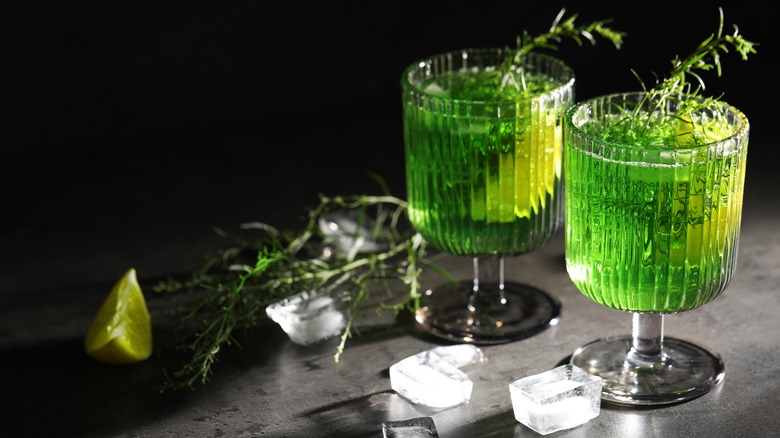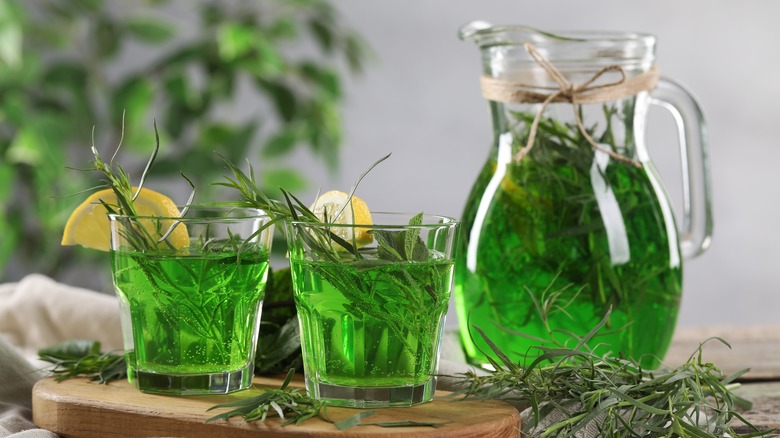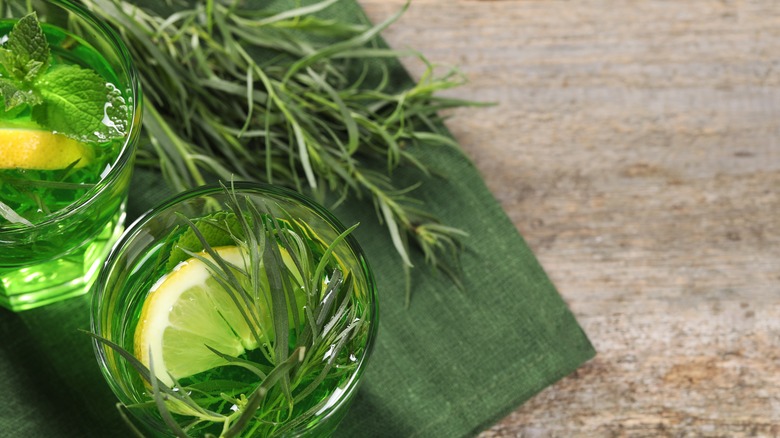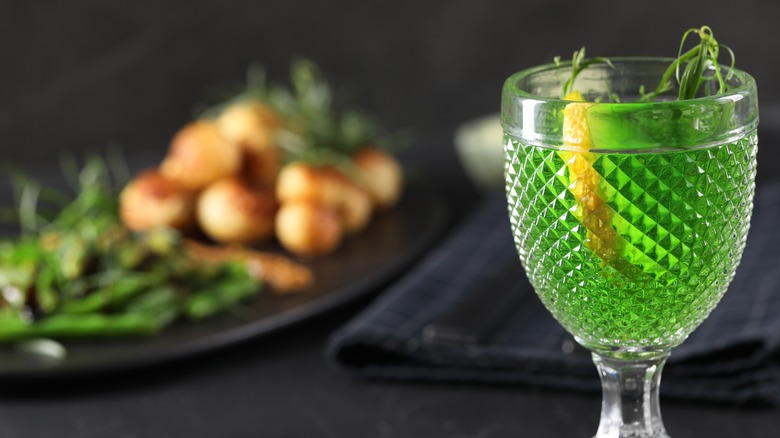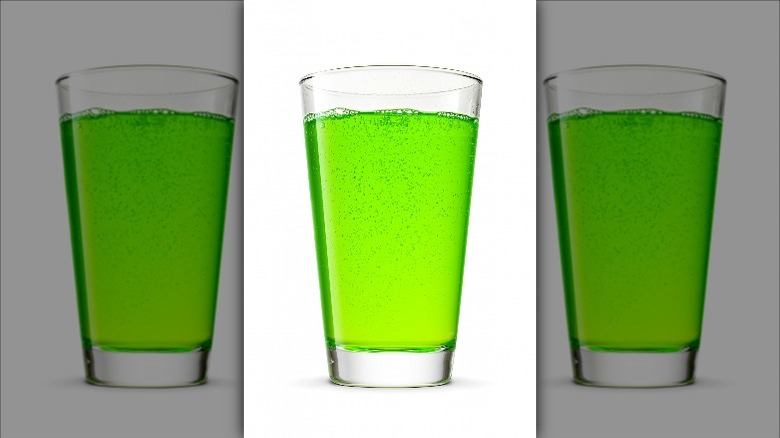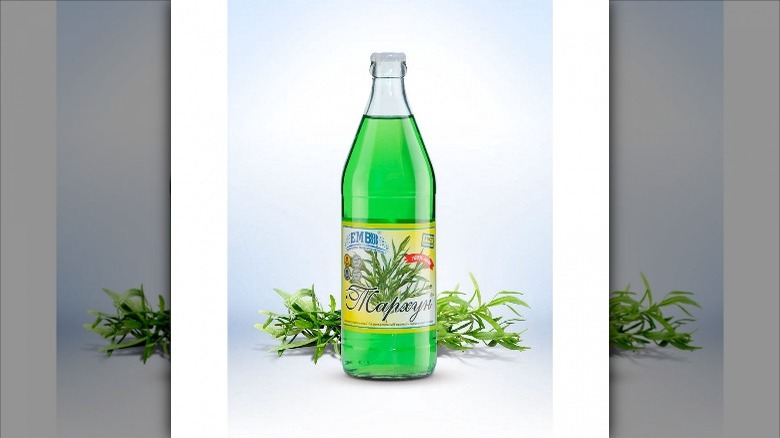Georgia's Tarragon-Flavored Tarkhuna Soda Has A Radioactive Hue
If you're ever doing a crossword puzzle and see the clue "soda from Georgia," it's likely that the first word that will pop into your mind (see what we did there?) is Coke, as America's (and the world's) most popular soda hails from A-Town. If you need an eight-letter word, you might try Coca-Cola, but what if that word starts with a "T?" Oh, in that case, it must be a soda from the other Georgia: the country in the Caucasus region. The drink those tricky crossword puzzle makers had in mind can only be tarkhuna — no capital letter, as the word is that of a flavor, not a brand name.
So what flavor is tarkhuna? Tarkhun is a Russian word meaning tarragon, even if Google Translate insists that it's Bulgarian and not Russian at all. Google does agree on the definition, at least, and this herb is what gives its namesake soda a distinctive flavor that some find refreshing while others find unpleasantly medicinal. While the flavor may come from a natural ingredient, the color most definitely does not: One of tarkhuna's distinctive characteristics is an artificial bright green hue that seems more extraterrestrial than earthy.
The history of tarkhuna
Tarkhuna dates back to the days of the tsars when Georgia was part of the Russian Empire. The drink was invented in 1887 by a Georgian pharmacist named Mitrofan Lagidze. While we don't have any information as to why he had tarragon syrup on hand, much less what made him think it would be a good way to flavor fizzy water, the journal Frontiers in Pharmacology reports that the herb has long been used as a digestive aid and may also have analgesic and anti-inflammatory properties. For these reasons, it checks out that a pharmacist may have had some on hand.
The original tarkhuna may not have gone 19th-century viral, but it did enjoy a second spurt of popularity nearly a century later. During the 1980s it was big in the Soviet Union, and this country (which included the area now known as the Republic of Georgia) bottled and sold the stuff under its current Russian (or, as Google would have it, Bulgarian) name. While the Soviet Union may have dissolved before the turn of the millennium, the soda is still sold in Russia and Georgia today. In fact, the very first brand ever manufactured comes from a soda company that was founded by Mitrofan Lagidze himself. It is called "Lagidze's Waters" ("Воды Лагидзе") and is still keeping afloat in its third century of operation.
What does tarkhuna taste like?
The dominant flavor note in tarkhuna is that of tarragon, of course. Well, that and sugar, as well as bubbles and fizz, although those provide more of a texture than a taste. As to what tarragon itself tastes like, it is known for having licorice or anise-like notes. There are actually three different types: French, Mexican, and Russian. Of the three of these, the Mexican one is the most licorice-y, but the Russian kind (which may be most often used in tarkhuna, although we cannot confirm this) tends to be more bitter. Tarkhuna may not be as sweet as many American soda brands, but for comparison purposes, it might be seen as having some similarity to sarsaparilla, birch beer, or maybe one of those types of root beer that tastes more of roots and than sugar or corn syrup.
Different brands of tarkhuna have slightly different flavor profiles. Napitki iz Chernogolovki (Напитки из Черноголовки) is very herbal and medicinal tasting, while Ostanskie Napitki (Останские Напитки) also has a cough drop-like quality to it, albeit less pronounced. Rosinka (Росинка) is the sweetest and most soda-like of this trio of popular Russian brands, with its licorice taste being cut by a hint of citrus flavor.
How is tarkhuna made?
There are two main ways to make tarkhuna, both of which involve different methods of extracting the tarragon flavor. One of these, which was employed by tarkhuna's inventor Mitrofan Lagidze, uses tarragon to infuse a simple syrup. In addition to tarragon, sugar, and water, some home recipes also call for lemon juice, while others will include the zest as well and may also add herbs such as fennel or aniseed for extra flavoring. Once the syrup is made, it can then be mixed with plain seltzer water to make tarkhuna soda.
The other way of making tarkhuna involves steeping fresh tarragon in water to which sugar, lemon juice, and lemon rind have been added. In this case, the drink will be still and not sparkling unless you use a SodaStream or similar appliance to introduce some carbonation. Both types of tarkhuna, however, will be lacking one thing that is characteristic of the commercial kind: the neon green coloring. The only way to get this is with the addition of food coloring, although you may be able to achieve a lighter, more subtle green tint by swapping out the lemon juice and rind for lime.
How to drink tarkhuna
While tarkhuna may be seen as a summery kind of drink, this is true of pretty much any kind of soda. Like all sodas, you can certainly drink it at any time of year if you're a fan of the flavor. If you're not so into the licoricey taste, though, you may still want to keep some on hand to drink in the event of any digestive upsets. Not only is tarragon said to relieve such distress, but carbonation, too, may provide at least some temporary relief.
What types of foods, though, are likely to be complemented by tarragon-flavored soda? Perhaps foods that themselves contain tarragon such as bearnaise sauce (here's our recipe) or salad dressed with tarragon vinegar. (The Olive Garden makes use of this herb, and so does our copycat dressing recipe.) Tarkhuna goes well with Georgian dishes, of course, as well as Russian foods and even Middle Eastern ones such as kabobs. It could also be paired with a dish as basic as tarragon-dusted french fries. Tarkhuna's herbal astringency means that it's best partnered with savory foods rather than desserts, although if you wish to challenge this assertion by making a tarkhuna ice cream soda, you go right ahead and do so. Film it for TikTok and who knows, you might start a trend or perhaps launch a challenge of sorts. (Coming up next: The couch medicine float.)
Where to buy tarkhuna
If you happen to be in Russia or Georgia, tarkhuna will be readily available from supermarkets and street vendors alike. In the U.S., you may stand a chance of finding it at Eastern European groceries and restaurants — not just the Russians and Georgians seem to be fond of the stuff, but also the Armenians, as well, so that extends the tarkhuna diaspora to some extent.
If you do not have ready access to such establishments and you don't wish to try making your own homemade tarkhuna, you still have one option left to you. It almost goes without saying, but of course, you can order it online. Several Amazon marketplace vendors carry the stuff, and even Walmart sells it. So do a number of sites specializing in Russian and other European imports. The most widely available brand available for online purchase seems to be Chernogolovka, but Walmart offers one made by another Russian company, Essentuki.
